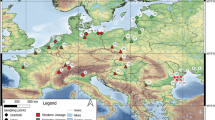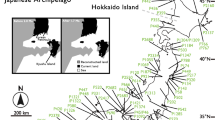Abstract
Marine species tend to exhibit relatively less population structuring than terrestrial species owing to fewer barriers to gene flow and increased connectivity resulting from greater dispersal abilities. Thus, in many cases, life history plays a more important role in phylogeography of marine taxa than do oceanographic features. Littoral species are of particular phylogeographic interest because they possess life histories that have both marine and terrestrial characteristics. This study evaluates the synergistic impact of divergent ocean currents and a high larval dispersal potential on the phylogeography of the fiddler crab, Uca maracoani, distributed along the coast of Brazil. Patterns of genetic variation were assessed with sequence data for a portion of the mitochondrial COI gene and AFLPs. Geometric morphometric techniques were used to evaluate morphological variation. Results revealed a lack of discernible genetic subdivision. However, geometric morphometrics showed statistically significant morphological differentiation. The absence of a clear phylogeographic pattern appears to be determined primarily by life history characteristics permitting a high level of connectivity. One, or a combination of several factors, may explain the incongruity between genetic and morphologic signatures, including phenotypic plasticity, incomplete lineage sorting, or recent and ongoing genetic divergence.





Similar content being viewed by others
References
Avise JC (2009) Phylogeography: retrospect and prospect. J Biogeogr 36:3–15
Barber PH, Palumbi SR, Erdmann MV, Moosa MK (2000) Biogeography—a marine Wallace’s line? Nature 406:692–693
Beerli P (2006) Comparison of Bayesian and maximum-likelihood inference of population genetic parameters. Bioinformatics 22:341–345
Beerli P (2009) How to use migrate or why are Markov chain Monte Carlo programs difficult to use? In: Bertorelle G, Bruford MW, Hauffe HC, Rizzoli A, Vernesi C (eds) Population genetics for animal conservation, vol 17., Conservation BiologyCambridge University Press, Cambridge, pp 42–79
Beerli P, Felsenstein J (2001) Maximum likelihood estimation of a migration matrix and effective population sizes in n subpopulations by using a coalescent approach. Proc Natl Acad Sci USA 98:4563–4568
Bookstein FL (1991) Morphometric tools for landmark data: geometry and biology. Cambridge University Press, Cambridge
Bowen BW, Bass AL, Muss A, Carlin J, Robertson DR (2006) Phylogeography of two Atlantic squirrel fishes (Family Holocentridae): exploring links between pelagic larval duration and population connectivity. Mar Biol 149:899–913
Clement M, Posada D, Crandall KA (2000) tcs: a computer program to estimate gene genealogies. Mol Ecol 9:1657–1659
Cowen RK, Lwiza KMM, Sponaugle S, Paris CB, Olson DB (2000) Connectivity of marine populations: open or closed? Science 287:857–859
Crane J (1975) Fiddler crabs of the world: Ocypodidae: Genus Uca. Princeton University Press, Princeton
Doyle JJ, Doyle JL (1990) Isolation of plant DNA from fresh tissue. Focus 12:13–15
Epifanio CE, Little KT, Rowe PM (1988) Dispersal and recruitment of fiddler crab larvae in the Delaware River estuary. Mar Ecol Prog Ser 43:181–188
Evanno G, Regnaut S, Goudet J (2005) Detecting the number of clusters of individuals using the software structure: a simulation study. Mol Ecol 14:2611–2620
Excoffier L, Lischer HEL (2010) Arlequin suite ver 3.5: a new series of programs to perform population genetics analyses under Linux and Windows. Mol Ecol Res 10:564–567
François O, Durand E (2010) Spatially explicit Bayesian clustering models in population genetics. Mol Ecol Resour 10:773–784
Fu Y-X, Li W-H (1993) Statistical tests of neutrality of mutations. Genetics 133:693–709
Galligan TH, Donnellan SC, Sulloway FJ, Fitch AJ, Bertozzi T, Kleindorfer S (2012) Panmixia supports divergence with gene flow in Darwin’s small ground finch. Geospiza fuligonosa, on Santa Cruz, Galápagos Islands 21:2106–2115
Guindon S, Gascuel O (2003) A simple, fast, and accurate algorithm to estimate large phylogenies by maximum likelihood. Syst Biol 52:696–704
Hellberg ME, Burton RS, Neigel JE, Palumbi SR (2002) Genetic assessment of connectivity among marine populations. Bull Mar Sci 70:273–290
Hopkins MJ, Thurman CL (2010) The geographic structure of morphological variation in eight species of fiddler crabs (Ocypodidae: genus Uca) from the eastern United States and Mexico. Biol J Linn Soc 100:248–270
Huelsenbeck JP, Ronquist F (2001) MrBayes: bayesian inference of phylogeny. Bioinformatics 17:754–755
Ituarte RB, D’Anatro A, Luppi TA, Ribeiro PD, Spivak ED, Iribarne OO, Lessa EP (2012) Population structure of the SW Atlantic estuarine crab Neohelice granulata throughout its range: a genetic and morphometric study. Estuaries and Oceans 35:1249–1260
Jensen JL, Bohonak AJ, Kelley ST (2005). Isolation by distance, web service. BMC Genetics 6: 13. v.3.23 http://ibdws.sdsu.edu/ Johnson WS, Allen DM (2005) Zooplankton of the Atlantic and Gulf coasts. Johns Hopkins University Press, Baltimore, Maryland
Kelly RP, Palumbi SR (2010) Genetic structure among 50 species of the Northeastern Pacific rocky intertidal community. PLoS ONE 5:e8594. doi:10.1371/journal.pone.0008594
Knowlton N, Weigt LA (1998) New dates and new rates for divergence across the Isthmus of Panama. Proc R Soc B 265:2257–2263
Koch V, Wolff M, Diele K (2005) Comparative population dynamics of four fiddler crabs (Ocypodidae, genus Uca) from a North Brazilian mangrove ecosystem. Mar Ecol Prog Ser 291:177–188
Librado P, Rozas J (2009) DnaSP v5: a software for comprehensive analysis of DNA polymorphism data. Bioinformatics 25:1451–1452
Melo GAS (1996) Manual de identificação dos Brachyura (caranguejos e siris) do litoral Brasileiro. Plêiade, São Paulo
Miner BG, Sultan SE, Morgan SG, Padilla DK, Relyea RA (2005) Ecological consequences of phenotypic plasticity. Trends Ecol Evol 20:685–692
Neethling M, Matthee CA, Bowie RCK, von der Heyden S (2008) Evidence for panmixia despite barriers to gene flow in the southern African endemic, Caffrogobius caffer (Teleostei: Gobiidae). BMC Evol Biol 8:325–333
Palumbi SR (1994) Genetic divergence, reproductive isolation and marine speciation. Annu Rev Ecol Syst 25:547–572
Peterson RG, Stramma L (1991) Upper-level circulation in the South Atlantic Ocean. Prog Oceanogr 26:1–73
Posada D (2008) jModelTest: phylogenetic model averaging. Mol Biol Evol 25:1253–1256
Posada D, Buckley TR (2004) Model selection and model averaging in phylogenetics: advantages of Akaike information criterion and Bayesian approaches over likelihood ratio tests. Syst Biol 53:793–808
Pritchard JK, Stephens M, Donnelly P (2000) Inference of population genetic structure using multilocus genotypes. Genetics 155:945–959
Rambaut A, Drummond AJ (2009) Tracer, version 1.5. Available from http://beast.bio.ed.ac.uk/Tracer
Rohlf FJ (1990) Rotational fit (Procrustes) methods. In: Rohlf FJ, Bookstein FL (eds) Proceedings of the Michigan morphometrics workshop, vol 2., University of Michigan Museum of Zoology Special PublicationAnn Arbor, MI, pp 227–236
Rohlf FJ (2010) tpsDig2.16. Available from http://life.bio.sunysb.edu/morph/
Ronquist F, Huelsenbeck JP (2003) MrBayes 3: bayesian phylogenetic inference under mixed models. Bioinformatics 19:1572–1574
Rosenberg MS (2001) The systematics and taxonomy of fiddler crabs: a phylogeny of the genus Uca. J Crust Biol 21:839–869
Schneider B, Schmittner A (2006) Simulating the impact of the Panamanian seaway closure on ocean circulation, marine productivity and nutrient cycling. Earth Planet Sci Lett 246:367–380
Schubart CD, Diesel R, Hedges SB (1998) Rapid evolution to terrestrial life in Jamaican crabs. Nature 393:363–365
Shanks AL (2009) Pelagic larval duration and dispersal distance revisited. Biol Bull 216:373–385
Sheets HD (2001–2007) Integrated morphometrics package. Canisius College, Buffalo, NY. Available from http://www2.canisius.edu/~sheets/morphsoft.html
Shulman MJ, Bermingham E (1995) Early life histories, ocean currents, and the population genetics of Caribbean reef fishes. Evolution 49:897–910
Silva IC, Mesquita N, Paula J (2010) Lack of population structure in the fiddler crab Uca annulipes along an East African latitudinal gradient: genetic and morphometric evidence. Mar Biol 157:1113–1126
Sotka EE (2012) Natural selection, larval dispersal, and the geography of phenotype in the sea. Integr Comp Biol 52:538–545
Spivak ED, Cuesta JA (2009) The effect of salinity on larval development of Uca tangeri (Eydoux, 1835) (Brachyura: Ocypodidae) and new findings of the zoeal morphology. Sci Mar 73:297–305
Swofford DL (2003) paup*: Phylogenetic analysis using parsimony (*and other methods), Version 4. Sinauer Associates, Sunderland
Tajima F (1989) Statistical method for testing the neutral mutation hypothesis by DNA polymorphism. Genetics 123:585–595
Taylor MS, Hellberg ME (2003) Genetic evidence for local retention of pelagic larvae in a Caribbean reef fish. Science 299:107–109
Teske PR, McQuaid CD, Froneman PW, Barker NP (2006) Impacts of marine biogeographic boundaries on phylogeographic patterns of three South African estuarine crustaceans. Mar Ecol Prog Ser 314:283–293
Thorson G (1950) Reproductive and larval ecology of marine bottom invertebrates. Biol Rev 25:1–45
Thurman CL, Faria SC, McNamara JC (2013) The distribution of fiddler crabs (Uca) along the coast of Brazil: implications for biogeography of the western Atlantic Ocean. Mar Biodiversity Rec. doi:10.1017/S1755267212000942
Vogt G, Huber M, Thiemann M, van den Boogaart G, Schmitz OJ, Schubart CD (2008) Production of different phenotypes from the same genotype in the same environment by developmental variation. J Exp Biol 211:510–523
Vos P, Hogers R, Bleeker M, Reijans M, Vandelee T, Hornes M, Frijters A, Pot J, Peleman J, Kuiper M, Zabeau M (1995) AFLP—a new technique for DNA fingerprinting. Nucleic Acids Res 23:4407–4414
Wares JP, Cunningham CW (2001) Phylogeography and historical ecology of the North Atlantic intertidal. Evolution 55:2455–2469
Weese DA, McLain DK, Pratt AE, Fang QQ (2009) Population structure of the Atlantic sand fiddler crab Uca pugilator along the eastern coast of US revealed by molecular data. Curr Zool 55:150–157
Wilgenbusch JC, Warren DL, Swofford DL (2004) awty: A system for graphical exploration of MCMC convergence in Bayesian phylogenetic inference. Available from http://ceb.csit.fsu.edu/awty
Young CM, Chia FS (1987) Abundance and distribution of pelagic larvae as Influenced by predation, behavior and hydrographic factors. In: Giese C, Pearse JS, Pearse VB (eds) Reproduction of marine invertebrates. Blackwell Scientific and the Boxwood Press, Palo Alto and Pacific Grove, pp 385–463
Zelditch ML, Swiderski DL, Sheets HD, Fink WL (2004) Geometric morphometrics for biologists. Elsevier Academic Press, New York
Zeller KA, Jurgenson JE, El-Assiuty EM, Leslie JF (2000) Isozyme and amplified fragment length polymorphisms (AFLPs) from cephalosporium maydis in Egypt. Phytoparasitica 28:121–130
Zink RM, Barrowclough GF (2008) Mitochondrial DNA under siege in avian phylogeography. Mol Ecol 17:2107–2121
Zwickl DJ (2006) Genetic algorithm approaches for the phylogenetic analysis of large biological sequence datasets under the maximum likelihood criterion. PhD Thesis, University of Texas, Austin
Acknowledgments
We graciously acknowledge the agencies and institutions that supported this research financially, logistically, and by providing permits: the University of Northern Iowa (UNI) Department of Biology Undergraduate Research Program; UNI Summer Undergraduate Research Program; the UNI College of Natural Sciences; the UNI Graduate College; the US Fish and Wildlife Service; the Fulbright Foundation; the University of Iowa Center for Global Regional Environmental Research; the Conselho Nacional de Desenvolvimento Científico e Tecnológico (Grants 300662/2009-2 to JCM, and 450320/2010-3 to JCM and CLT); the Fundação de Amparo à Pesquisa do Estado de São Paulo (Grant 2009/50799-0 to JCM and CLT); the Coordenadoria de Aperfeiçoamento de Pessoal de Ensino Superior; and the Centro de Biologia Marinha/USP at São Sebastião, SP. Specimen collection and export of tissues and extracted DNA were authorized by the Instituto Brasileiro do Meio Ambiente e dos Recursos Naturais Renováveis (IBAMA, permits #2009/18559-1 and #2010/23976-1 to JCM). We also thank Dr. Gary and Myrna Floyd who kindly provided undergraduate financial support for A. C. Wieman; K. H. Fehlauer-Ale, L. C. Branco, and Samuel C. Faria (USP, Brazil) for assistance with initial DNA extractions and field work; K. Berge, S. Holmes and J. Woodin (UNI) for laboratory assistance; and A.R. Warwick (Florida State University) for comments on the manuscript.
Author information
Authors and Affiliations
Corresponding authors
Additional information
Communicated by C. Riginos.
Electronic supplementary material
Below is the link to the electronic supplementary material.
Rights and permissions
About this article
Cite this article
Wieman, A.C., Berendzen, P.B., Hampton, K.R. et al. A panmictic fiddler crab from the coast of Brazil? Impact of divergent ocean currents and larval dispersal potential on genetic and morphological variation in Uca maracoani . Mar Biol 161, 173–185 (2014). https://doi.org/10.1007/s00227-013-2327-0
Received:
Accepted:
Published:
Issue Date:
DOI: https://doi.org/10.1007/s00227-013-2327-0




